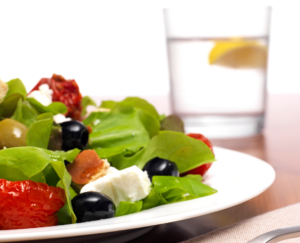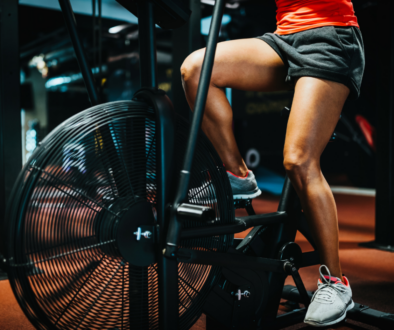3 Things You Can Do Right Now to Improve Your Nutrition
 If you want to feel fitter and healthier, be in a better mood, and have more energy all day long, start making small improvements to your nutrition. If you don’t know where to begin (or if you’ve gotten a little off track this season) here are 3 things you can do right now to improve your nutrition.
If you want to feel fitter and healthier, be in a better mood, and have more energy all day long, start making small improvements to your nutrition. If you don’t know where to begin (or if you’ve gotten a little off track this season) here are 3 things you can do right now to improve your nutrition.
1. Drink 100oz of water daily
Always start with adding rather than subtracting. Instead of trying to kick a soda or coffee habit, set a daily water intake target for yourself. While 100oz daily is the ultimate goal, you may not need to start there to see benefits. Track your intake for a day or two and if it’s less than 80oz, start by adding 20oz . When that becomes a solid habit, increase your target by another 20oz (working your way up to 100oz). I know your next questions is what “counts” as water. While drinks other than water can contribute to hydration, remember the reason why you’re taking on this project: You want to be healthier, fitter, and more energized. Soda, coffee, juice, and sugary drinks aren’t going to get your there. I recommend “counting” water, water with no sugar electrolytes like these mixed in, carbonated unsweetened drinks, decaffeinated unsweetened coffee and teas, and you can give yourself credit for water in smoothies, broths, and soups.
A few strategies…
Use a water-tracking app, keep track on the notes app on your phone, or keep track in your daily planner (that’s my strategy!). Be sure to finish your water bottle before topping off so you get an accurate count. If you need help hitting your target, try one of these: Prefill one large container of water that matches your goal and refill your water bottle or glass from that all day. It helps if the container is clear so you have a visual reminder. Another option is to buy several water bottles (enough to equal your target), prefill those in the morning, and finish them every day. Of you don’t want to carry several water bottles, place 3 or 4 rubber bands around the top of one bottle and each time you finish and refill it, move a band to the bottom. Your goal is to move all the bands from the top to the bottom every day. Whichever strategy you choose, here are a few more helpful hints: Carry a water with you everywhere. Don’t wait to start drinking water. Hydrate as soon as you wake up. If you’re a coffee drinking, prep your coffee before bed and fill your our mug with water. In the morning you’ll have to slam 120z of water before you can have your coffee.
2. Eat a high-protein (preferably low-sugar) breakfast
I could have called this tip stop eating dessert for breakfast! While you may not be eating the obvious sugary breakfast foods typical in our culture (like pancakes, waffles, french toast, muffins, and other pastries), I’m afraid you’re not doing much better by eating foods masquerading as healthy breakfast foods (like fruit, granola, cereal, and bagels). Breakfast, like lunch and dinner, should be savory. Make this mental shift and you’ll be on the right track. Anything you’d eat for lunch or dinner, can be eaten for breakfast. If that sounds like too much of a stretch, there are great savory American breakfast options: eggs, sausage, bacon, etc. Or go plant-based with a tofu scramble or a tempeh wrap. And if you really can’t stomach a savory meal in the morning, add no-sugar protein powder to oatmeal or overnight oats or have a breakfast protein smoothie. If you’re like most of my clients, you’re already eating protein for lunch and dinner, but breakfast is an area for improvement. Stop “skipping breakfast” or eating cereal, fruit, or granola and check out this post for more ideas for high-protein low-sugar breakfast recipes.
3. Stop eating 2-3 hours before bed
I know intermittent fasting is a hot “new” topic these days. But unless you’ve been sleep-eating your whole life, you’re already practicing intermittent fasting! Did you ever notice first meal of the day is called break-fast? You can never actually “skip breakfast” because your first meal of the day breaks your fast. The problem with the today’s popular concept of IF, however, is that influencers and biohackers are recommending an eating window that starts at lunch and ends close to bedtime. But that’s not how our biology works. You can read more about chrononutrition here. Basically we humans are diurnal (active during the day). Our internal clocks dictate that digestion and metabolism work optimally when the sun is up. If you want to have a good night’s sleep, maintain a healthy weight, and maximize the window of growth hormone release (to build muscle and recover from workouts), stop eating 2-3 hours before bed. You’ll have that same 8-, 10-, or 12-hour eating window, but it’ll start with breakfast in the morning and end with dinner. Revolutionary, I know! If you’re still not convinced that meal timing matters, look at your eating habits in those last couple hours before bed. At the end of the day, you’re probably not temped by celery and carrots. Instead, it’s ice cream, cookies, chips, and alcohol that are calling your name. The solution is to set a rule that you stop eating 2-3 hours before lights out.
If these 3 tips for improving your nutrition sound overwhelming, pick just one to start with. Track your progress and how you’re feeling. If you encounter struggles, come up with creative solutions that work for your life. But don’t give up! You can look and feel better (inside and out) with a few healthy habit upgrades to your daily nutrition.
This post contains affiliate links.



